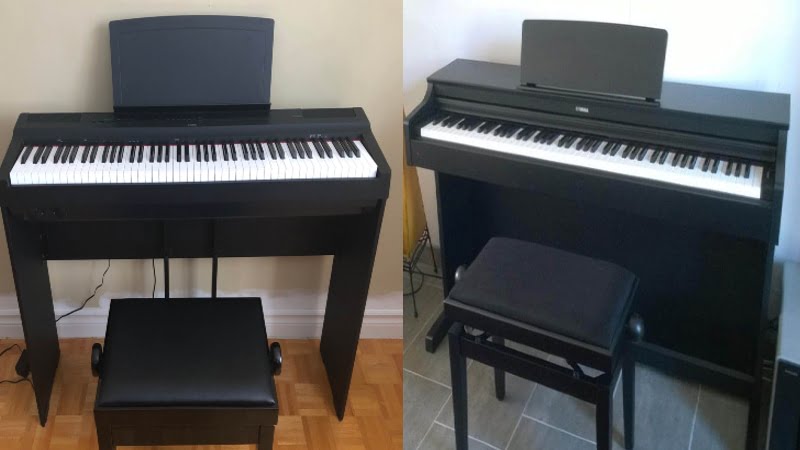Find out which Yamaha piano is the best option for you in this Yamaha P125 vs YDP 164 comparison!
Yamaha is one of the world’s most popular digital and acoustic piano brands. And two digital pianos from the brand that are regularly put up against each other are the Yamaha P-125 and the Yamaha YDP-164.
Both of these pianos are loved in the piano community, so it’s easy to see why many people choose between the two when shopping for a digital piano.
And if you’re having a hard time choosing the right option for you, you’ve come to the right place.
After rigorous testing and research, I realized that the Yamaha P-125 is the better option simply because it’s more flexible. That said, there are still some benefits to the YDP-164, so there are many pianists who might find this to be the right piano for them.
In this Yamaha P-125 vs YDP-164 comparison, I’ll be looking closely at both pianos. We’ll dive into their features, pros, and cons so it will be much easier for you to find the right one for your needs.
Yamaha P125 vs YDP 164: Comparison Chart
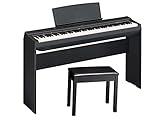



Last update on 2025-07-06 / Affiliate links / Images from Amazon Product Advertising API
Yamaha P125 vs YDP 164: A Head-to-Head Comparison
It would be easy to assume that the YDP-164 is the better piano because it’s more expensive. And while the Yamaha YDP-164 is definitely high-quality, it can’t compete with the flexibility of the Yamaha P-125.
That’s why when I compared these two pianos head-to-head, the Yamaha P-125 came out on top with a score of 2-1. The YDP-164 easily took the points when it came to the feel, but the Yamaha P-125 won out in every other category, which is why it came out on top in the end.
Feel
The winner: YDP-164
One of the most important features to consider when buying a digital piano is the feel. You always want to get a digital piano that replicates the feeling of playing an acoustic piano. And because the YDP-164 has textured keys and graded hammer action, I found that it feels way more realistic than the Yamaha P-125.
+Hammer Action
Despite the YDP-164 costing almost two times as much as the P-125, both pianos have the same hammer action system. You’ll find that the YDP-164 and the P-125 use the Yamaha Graded Hammer Standard or GHS.
This is a hammer action meant to replicate the subtle weight differences between the piano keys. So, the lower keys on the piano will be slightly heavier than the lighter keys, which is why both pianos do a great job of replicating the weight of an acoustic piano.
But since the YDP-164 is a console digital piano, it inherently feels a bit more realistic than the P-125. And I’ll get to the exact reason why in the next section.
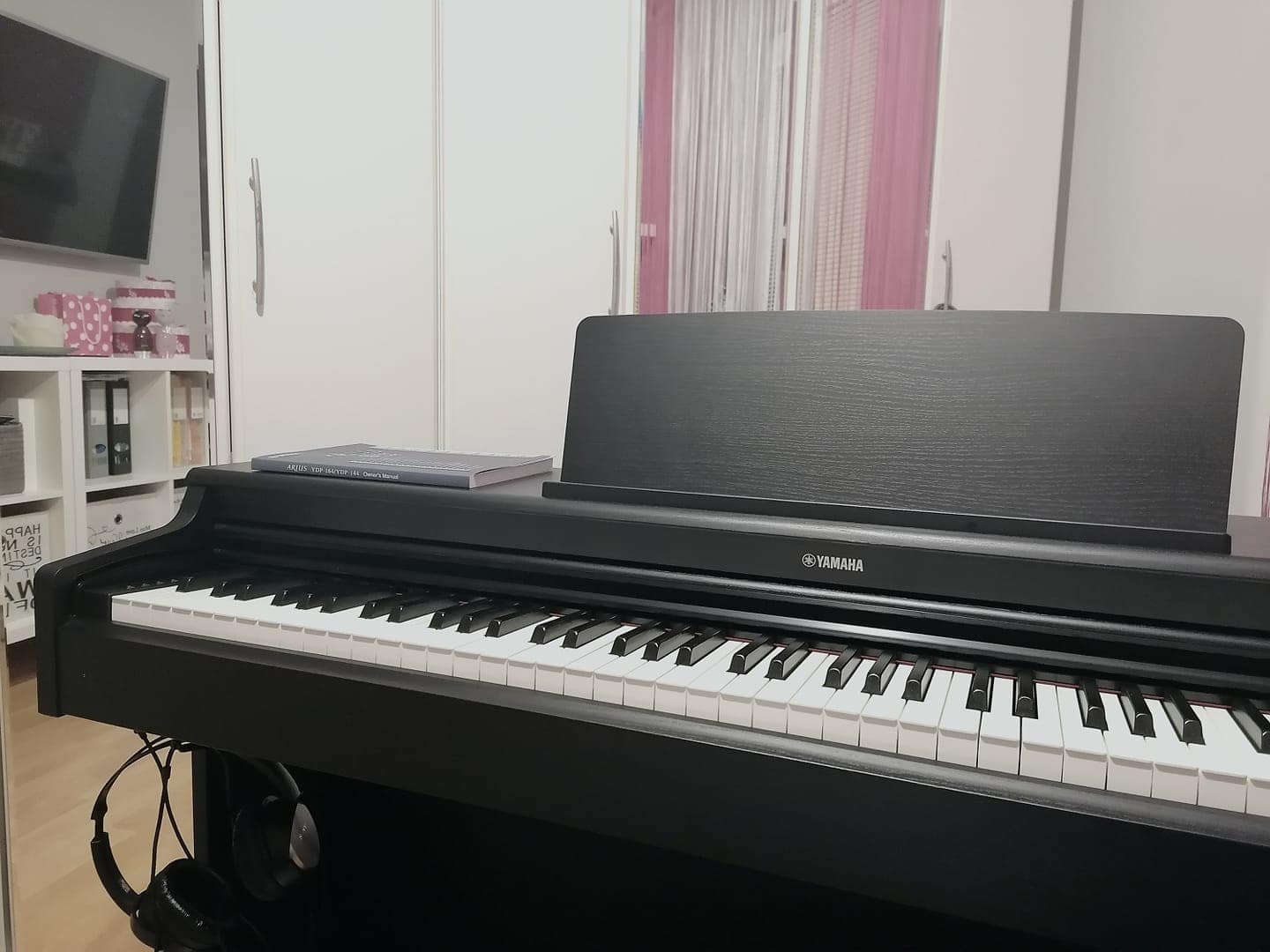
+Key Texture
The main reason I found that the YDP-164 felt more realistic than the P-125 was because of the key texture. The P-125 comes with glossy plastic keys, which you would expect in this price range. And while this isn’t necessarily a bad thing, I noticed that the keys had a plastic feel which took away a lot of the realism.
The YDP-164, even if it also uses plastic keys, has a subtle coating on the keys. These give the keys on the YDP-164 a matte finish and texture. This feels closer to the real wooden keys you’ll find on acoustic pianos and is the reason the YDP-164 felt way more realistic compared to the P-125.
The YDP-164 has a more premium feel because it’s the more premium piano. At almost twice the price of the P-125, you’d expect it to come with more premium features and a realistic feel. And while the feel of the Yamaha YDP-164 is more realistic, I quickly learned that P-125 might actually have more premium features.
Tone
The winner: Yamaha P125
You’d expect a console digital piano to have a richer tone than a portable digital piano. And while the speakers and design of the Yamaha YDP-164 produce a very wide and realistic tone, I found that the P-125 actually has a better sound and a wider sound library.
So, despite the price difference, the Yamaha P-125 actually came out on top when I compared it to the YDP-164’s tone.
+Tone Generator
These pianos use different tone generators. The Yamaha P-125 has the Pure CF Sound Engine, while the YDP-164 has the CFX Stereo Sampling. Technically, the CFX Stereo Sampling engine is more expensive and modern than the Pure CF engine, but I found the difference to be barely noticeable.
To find which piano had the better tone engine, I decided to do a sound test. And when I plugged the pianos into the same set of speakers, I could barely tell the difference between the piano sounds. Both pianos were able to produce very rich and bright tones, which you would expect from a Yamaha digital piano.
That said, the Yamaha YDP-164 had a slight advantage when using the built-in speakers. This is because the speakers on the YDP-164 are placed in a way that replicates how sound travels through the air with an acoustic piano.
However, considering that the price difference between the two is almost a thousand dollars, I don’t think that YDP-164’s tone is that much better to justify the price. So, when it comes to value for the money, the P-125 actually offers more in terms of tone than the YDP-164.
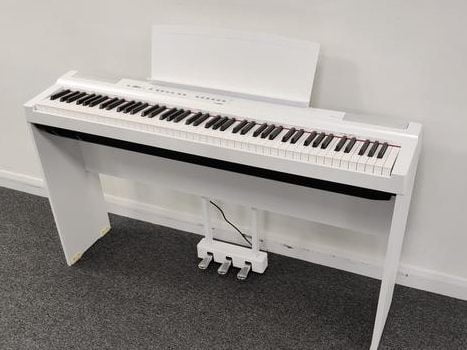
+Sound Library
Console digital pianos are designed to replicate the sound and feel of an acoustic piano. So, don’t expect the YDP-164 to come with the most varied set of tones.
The YDP-164 comes with ten different voices. For a console digital piano, this is actually a lot. This piano allows you to choose between various piano, electric piano, bass, and string tones. You won’t find this much variation with other digital console pianos in its price range, but it definitely pales in comparison to the P-125.
Even if it’s the more affordable model, the P-125 comes with 24 different voices. While they fall under the same categories, the P-125 offers more choices for each type of voice. That way, you can easily find a preset that fits the music you playing and your own style.
Piano Features
The winner: YDP-164
The next comparison point I had with these two pianos was the piano features. This includes the extra playing modes, polyphony, and built-in effects. And since the P-125 is designed to be used in gigs, practice, and jam sessions, you can expect it to have more features.
This was ultimately the reason I chose the P-125 as the winner and why you might find it to be the better option as well. So, here’s a quick rundown of the different piano features you’ll find on either piano.
+Playing Modes
Let’s start by talking about the playing modes. The only additional mode you have with the YDP-164 is duo mode, which is designed for piano lessons and duets. With this mode, you can divide the keyboard into two smaller pianos with the same pitch and voice.
That way, the teacher can play along with the student without worrying about pitch differences. And while this is a very useful playing mode for teachers, it would’ve been nice to see other playing modes on this piano.
The P-125 comes with split and dual modes on top of the duo mode. With split mode, you can assign one voice to one half of the piano and another voice to the other side. For example, you can have a bass voice on the lower notes and a piano voice on the higher notes so you can fill in more sonic space.
With dual mode, you can blend two voices together. That way, it’s like you’re playing two instruments at the same time.
Both of these modes are great for live settings and for jamming with friends. Because of this, I believe that you’ll find more uses for the P-125 compared to the YDP-164.
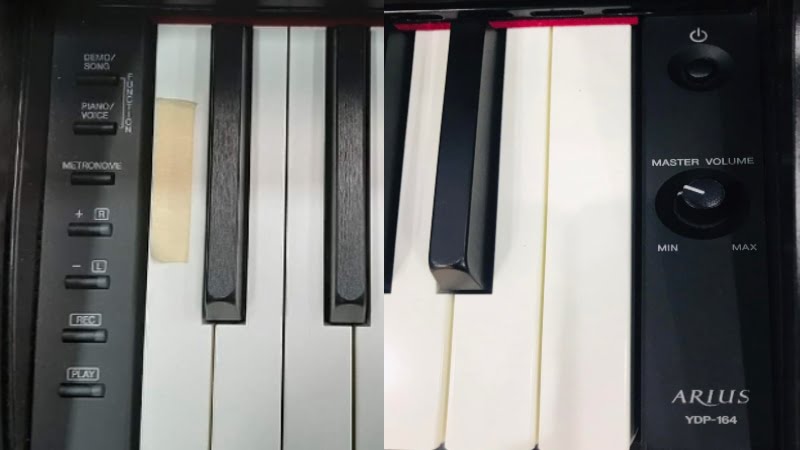
+Polyphony
Polyphony refers to the number of sounds a piano can play at a time. In the past, this was a major consideration as we didn’t have as much computing power before, so it was hard to find a piano that had a high maximum polyphony.
Nowadays, things are different. Since we have more powerful computers now, it’s easier to find a piano with a high maximum polyphony. Both the YDP-164 and the P-125 have 192-note maximum polyphony, so you won’t have to worry about playing chords with many notes when playing either piano.
+Effects
The last set of piano features I compared were the built-in effects. And to my surprise, the Yamaha P-125 had a wider effect set that gives you more control over the tone.
The P-125 comes with reverb, IAC, damper resonance, and a sound boost. Granted, most of these effects make small differences, but they give you significantly more control over your tone than other digital pianos.
The YDP-164, on the other hand, only has one effect: reverb. This is probably the most useful effect for beginners and experienced pianists. However, if you’re looking for maximum control over your tone, the P-125 might be the better option for you.
Yamaha P125 vs YDP 164: The Similarities
These are two very different pianos, which is why I had a great time comparing them. Almost every feature between the two was different, from the tone engine down to the sound library and effects. However, that doesn’t mean that you can’t find any similarities between the two.
To start, both pianos come from Yamaha, one of the most trusted digital piano brands on the market. So, you won’t have to worry about either piano being low-quality. In fact, I would gladly recommend either piano to any pianist looking for a reliable instrument.
On top of that, both pianos have 192-note maximum polyphony. This means you won’t have any trouble playing many notes at the same time. This is fairly common nowadays as computers have become much stronger and more accessible.
That said, while both pianos are great, I still prefer the P-125. It comes at a lower price, has high-quality tones, a wider sound library, and is the more versatile option overall. The YDP-164 is best for home use, but if you need a piano you can bring to gigs, practice, and lessons, the P-125 is the easy pick.
Quick Rundown of the Yamaha P125
- Includes P125B digital piano, L125B furniture stand, BB1 wooden bench
- A fully weighted digital piano with 88 full sized piano style keys
- GHS weighted action is heavier in the low keys and lighter in the high keys, just like an acoustic piano
- The pure CF sound engine faithfully reproduces the tone of the acclaimed Yamaha 9' CFIIIS Concert Grand piano
- USB to host connectivity with MIDI and audio transfer means you only need 1 Cable to connect to your music making software
Last update on 2025-07-06 / Affiliate links / Images from Amazon Product Advertising API
Quick Rundown of the Yamaha YDP 164
- Your purchase includes One Yamaha Arius Series, YDP164 model | Bench, 50 Classical Music Masterpieces Book, Owner’s manual & Quick Operation Guide
- Piano dimensions – 53-7/16” W x 33-27/64” H x 16-5/8” | Weight – 92 lbs. | Number of pedals – 3 | Max polyphony – 192 | Number of voices – 10 | Headphones – (2) Standard Stereo phone jack | With Recording and Playback capabilities
- GHS weighted action is heavier in the low keys and lighter in the high keys, just like an acoustic piano
- Half-damper pedal control allows for continuously increasing amounts of sustain as the pedal is depressed
- The CFX Premium Grand Piano Voice recreates the power and tone of the flagship CFX concert grand piano from Yamaha
Last update on 2025-07-06 / Affiliate links / Images from Amazon Product Advertising API
Product Videos
Related Articles to Yamaha P125
- Yamaha P150 vs P125: The Battle of the P-Series Models
- Yamaha P125 vs CLP 625: Can a Beginner’s Digital Piano Match the Clavinova?
- Yamaha P125 vs Roland FP 60: Which is the Better Investment?
- Yamaha P-121 vs P-125: Finding the Best Portable Yamaha Piano
- Yamaha P125 vs Korg LP 380: Which Piano Is Better for Your Needs?
- Yamaha P125 vs P85: Can the Outdated Digital Piano Beat the Newer One?
- Yamaha P125 vs DGX 670: Which Piano Comes Out on Top?
- Yamaha P125 vs Korg SP 280: Which is the Better Beginner’s Digital Piano?
- Yamaha P-255 vs P-125: Finding the Better Option for Beginners
- Yamaha P125 vs YDP S34 Comparison: Does the Portable P125 Hold Up Against a Console Digital Piano?
- Yamaha YDP 103 Vs P125: Should You Get a Portable or Console Digital Piano?
- Yamaha P125 Vs Kawai ES110 Comparison: Which Is The Best Portable Digital Piano
- Yamaha P125 vs Casio PX S1000: Which Digital Piano Is Worth Your Money?
- Casio PX-870 Vs Yamaha P-125: Should You Get A Portable Or Console Digital Piano?
- Alesis Recital Vs Yamaha P125: Which Is The Right Pick For You?
- Yamaha P45 VS P115: Which P-Series Newbie Gives You More Value for Money?
- Alesis Recital Pro vs Yamaha P125 Comparison: Which Is The Best Portable Digital Piano?
- Alesis Prestige Artist vs Yamaha P125 Comparison: Why the Yamaha P125 Is the Better Investment
- Yamaha P125 vs Casio PX-770 Review: Why the Yamaha P125 Beats Out the Casio Console Digital Piano
- Yamaha P125 vs DGX 660 Comparison: Can the P125 Hold Its Own Against the DGX 660?
- Yamaha P125 vs Roland FP-30X Review: Why the Roland FP-30X Comes Out On Top
- Yamaha P125 vs P515 Review: Why the Yamaha P515 Is the Better Investment
- Yamaha P115 vs P125 Review: Can the P125 Beat Out Its Predecessor?
- Yamaha P125 vs Roland FP30: A Close Battle Between Two Great Digital Pianos
- Yamaha P45 vs P125: Why the Yamaha P125 Is the Better Pick for Pianists
- Yamaha P71 vs P125: Why the Yamaha P125 Is the Better Investment
Related Articles to Yamaha Ydp 164
- Yamaha YDP-144 vs 164: Which Is the Better Arius Piano?
- Yamaha YDP-164 vs DGX-660: Why You Should Go for the DGX-660
- Casio PX-870 Vs Yamaha YDP-164: Which Is The Better Choice For Beginners?
References:
- Yamaha P125: https://usa.yamaha.com/products/musical_instruments/pianos/p_series/p-125/specs.html#product-tabs
- Yamaha YDP 164: https://www.sweetwater.com/store/detail/YDP164RW–yamaha-arius-ydp-164-digital-home-piano-with-bench-rosewood
Lulacruza is an electronic folk duo operating at the junction of the hypermodern and the ancient. Our music weaves together hypnotic female singing, South American folk instruments and electronic processing, while channeling pulsating waves from the source of creation.
Lalucruza is also a community where you can connect with other music lovers to collaborate, exchange ideas and share knowledge. A platform for who wants to learns the basics of playing piano, guitar, drum masters’ technique, etc.. is the premise of our website.
